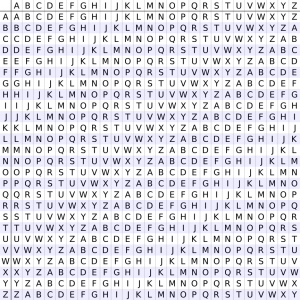Vigenere
Vigenère Cipher
The Vigenère cipher is a polyalphabetic substitution cipher that was developed in the 16th century by a French cryptographer named Blaise de Vigenère. It is named after him due to his contribution to the development and popularization of the cipher.
Blaise de Vigenère enhanced the earlier Alberti cipher, invented by Leon Battista Alberti in the 15th century. The Alberti cipher used a single mixed alphabet and a “Cipher Disk” device for encryption and decryption. Vigenère’s improvement introduced the use of a repeating keyword or phrase to determine shifts, making it a more secure polyalphabetic cipher compared to monoalphabetic ciphers like the Caesar cipher.
The Vigenère cipher was widely acclaimed and considered unbreakable for many years, earning the name “le chiffre indéchiffrable” or “the indecipherable cipher” in French. However, in the mid-19th century, mathematician Charles Babbage discovered a method to crack it using frequency analysis.
Despite its vulnerability, the Vigenère cipher had a significant impact on cryptography. It paved the way for the development of more advanced ciphers and encryption techniques. Today, it is commonly used as an educational tool to introduce polyalphabetic substitution ciphers and emphasize the importance of key management in cryptography.
Encryption Process
Encrypting a Message
- Choose a secret keyword or phrase (e.g., “SECRET”).
- Write down the message you want to encrypt (e.g., “HELLO WORLD”).
- Convert the keyword and message to uppercase and remove any spaces or special characters.
- Using the Vigenere table(one the right) Find the row corresponding to the first letter of the keyword and the column corresponding to the first letter of the message. The intersection of the row and column represents the encrypted letter.
- The message first letter H with the first keyword letter S encrypts to B.
- Repeat step 5 for each letter in the message using the next letter in the keyword.
-
Keyword: S E C R E T S E C R E T
-
Message: H E L L O W O R L D
-
Encrypted: Z I N C S P G V J U
-
- The encrypted message is “Z I N C S P G V J U”.
Decryption Process
Decrypting a Message
Decrypting is exactly the same method as encrypting, except in reverse.
- Start with the encrypted message (e.g., “Z I N C S P G V J U”).
- Write down the keyword used for encryption.
- Find the row corresponding to the first letter of the keyword and the column corresponding to the first letter of the encrypted message. The intersection of the row and column represents the decrypted letter.
- The first encrypted letter B, with the first keyword letter S decrypts to H
- Repeat for each letter:
-
Keyword: MORSE -
Encrypted: IVR LLM GXG HIF RMK TH -
Decrypted: WHAT HAS GOD WRAUGHT
-
- The decrypted message is “Hello World”
Pros and Cons
Advantages of Vigenère Cipher
- Polyalphabetic Encryption: The Vigenère cipher uses multiple cipher alphabets, making it more secure than simple substitution ciphers. Each letter in the plaintext can have multiple corresponding ciphertext letters, adding complexity to the encryption.
- Key Management: The Vigenère cipher relies on a keyword or phrase as the encryption key. This key can be easily changed for different messages, providing flexibility in encryption. The key length and complexity can enhance the security of the cipher.
- Resistance to Frequency Analysis: Unlike monoalphabetic ciphers, such as the Caesar cipher, the Vigenère cipher does not preserve the frequency distribution of letters in the plaintext. This makes it more resistant to frequency analysis, a common method of breaking simple substitution ciphers.
Disadvantages of Vigenère Cipher
- Vulnerable to Kasiski Examination: The Vigenère cipher is susceptible to the Kasiski examination, which is a technique used to analyze repeated patterns in the ciphertext. Repeated sequences can reveal information about the keyword length and eventually lead to decryption.
- Key Length Consideration: The security of the Vigenère cipher depends on the length and randomness of the keyword. If the keyword is short or easily guessable, the cipher becomes weaker. Long and random keywords are harder to remember and manage.
- Known-plaintext Attacks: If an attacker knows or can guess parts of the plaintext and the corresponding ciphertext, they can deduce information about the keyword. This knowledge can aid in breaking the cipher.
- Lack of Authentication and Integrity: The Vigenère cipher only provides confidentiality for the message, but it does not provide authentication or integrity. It is susceptible to tampering and impersonation attacks.

